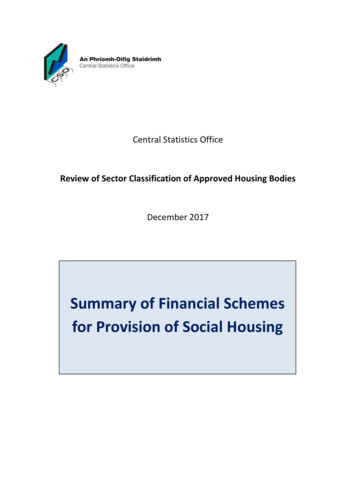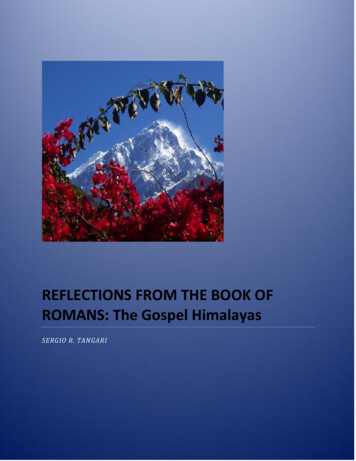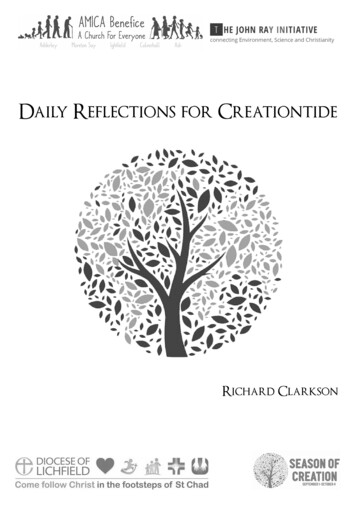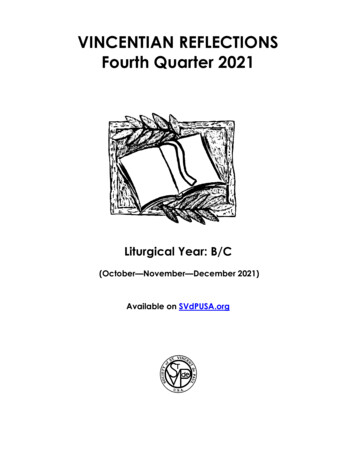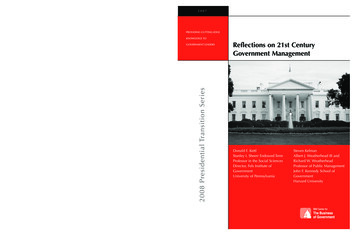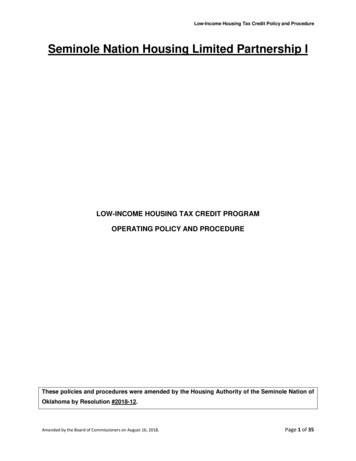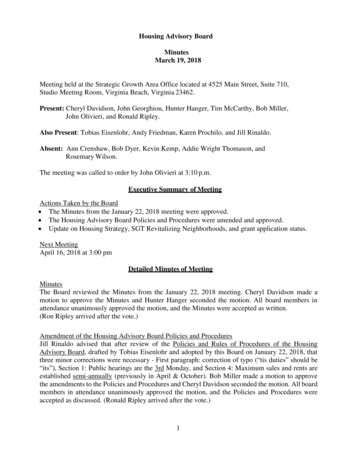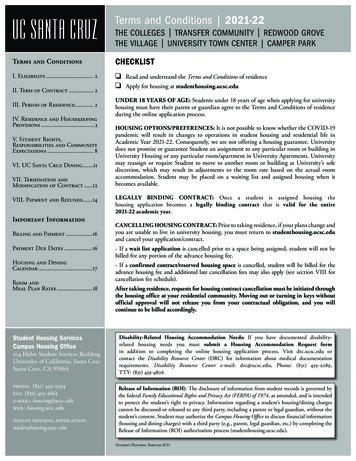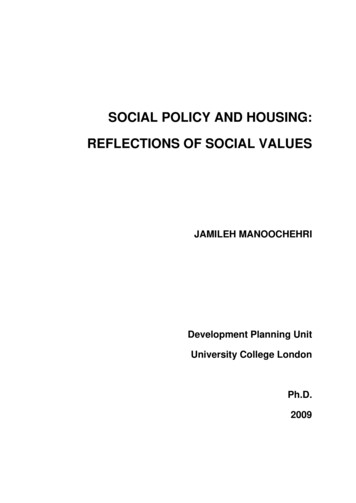
Transcription
SOCIAL POLICY AND HOUSING:REFLECTIONS OF SOCIAL VALUESJAMILEH MANOOCHEHRIDevelopment Planning UnitUniversity College LondonPh.D.2009
I, Jamileh Manoochehri, confirm that the work presented in this thesis is myown. Where information has been derived from other sources, I confirm thatthis has been indicated in the thesis. .Jamileh Manoochehri
ABSTRACTThis thesis set out to find the correlation between social values and standards insocial housing in two major milestones in the developments in state-providedhousing. The new spirit of optimism after the Second World War was developed bythe latter part of the 1960s into the influential Parker Morris report. Having beencommissioned by a Conservative Government in 1959 it was made obligatory forsocial housing in 1967 by the Labour Party in government. The post-war years thatheralded the inception of the welfare state in Britain and are often referred to as theConsensus years, are investigated here and found to be centered on a socialdemocratic agenda. In contrast with the above period, the post-1979 years becameidentified with their embrace of a liberal agenda, formulated by neo-liberal thinkersand politicians. This period which has the hallmarks of what has been referred to asa neo-liberal consensus was identified by the state efforts to reverse the socialdemocratic agenda of the post-war years. Substantial social policy changes can beidentified in the two contrasting periods, manifested particularly in the adoption ofthe universalist approach to social policy in the former with the selectivist approachin the latter period. This thesis investigates the factors that led to changes instandards in social housing in the two periods by searching for correlations betweenpolicy changes from universalism to selectivism and the dominant social values ofthe time. A number of housing estates were selected and the space andenvironmental standards in them were compared to verify the changes instandards. The political Party manifestos, policy documents, committee papers andrecommendations were analysed to find indications of the state’s ideological stanceat the given periods. The policy statements and social and housing policies werealso analysed to find the correlation between the string of factors that lead from thestate to the final built artefact in the form of social values, social policies, housingpolicies and social housing standards. In order to verify the findings of the research,semi-structured informal interviews were conducted with prominent actors inprovision of social housing. In addition two housing estates were studied in detail ascase studies of each period. The research found that the periods of ascendancy ofsocial democratic ideology in the state, and social values based on the significanceof the collective society and the equality of all citizens led to higher space standardsin social housing, while the periods of ascendancy of neo-liberal ideology in thestate, and social values based on the significance of individual action based ondominance of market relations led to a drop in social housing standards. Asignificant finding of this research was the importance of individual actors involvedin the provision of social housing and their role in interpreting regulations in favour(or against) promoting higher or lower standards.PhD Thesis - Jamileh Manoochehri3
AcknowledgementsThe completion of this project has been made possible through the patientand determined support of my supervisor Ronaldo Ramirez over manyyears, and the assistance of Dr. Robert Biel who helped it navigate its waythrough the university requirements.My deepest gratitude goes to my mother, the pillar of our lives, for her warmand selfless support for me and my family especially during the prolongedperiod of completion of this research, to my son Anoosheh and my daughterMitra, the joys of my life for patiently sharing their mother’s attention with herresearch for most of their young lives, to my dear husband without whoseinvaluable support this endeavour would not have been possible and to myfather for being a constant reminder of the value of human passion forknowledge.I am grateful to David Levitt and Neave Brown, whose interviews were agreat pleasure as well as being immensely informative. In completing thisresearch I enjoyed extensive co-operation from Directors of Levitt BernsteinArchitects, who gave their time generously looking for information throughtheir archives and for discussions. I am also grateful to Clive Clowes forgiving his time generously for the interview.I would also like to thank my employers, Dr. Gerard Moran, Dean of Facultyof Art and Design at De Montfort University as well as Dr. Hassan Abdalla forallowing me sufficient study leave in the final months to complete this thesis.PhD Thesis - Jamileh Manoochehri4
Table of ContentsCHAPTER 110INTRODUCTION101.1 RESEARCH FIELD111. 2 THEORETICAL FIELD151.3 RESEARCH QUESTIONS191.4 RESEARCH PROPOSITIONS201.5 STRUCTURE OF THE THESIS211.6 CONCLUSIONS24CHAPTER 226CHRONOLOGY OF MILESTONES IN HOUSING POLICY262.1 SOCIAL HOUSING IN BRITAIN BEFORE 1945262.1.1 SOCIAL HOUSING AND THE TRANSITION FROM THE 19TH INTO 20TH CENTURY262.1.2 SOCIAL HOUSING IN THE FIRST THIRD OF THE 20TH CENTURY – THE TUDOR WALTERS REPORT312.1.3 POST-TUDOR WALTERS REPORT - POLICY CHANGES352.2 EMERGENCE OF A SOCIAL DEMOCRATIC CONSENSUS: 1945-1964382.2.1 UNIVERSALISM VERSUS SELECTIVISM382.3 CONSOLIDATION OF THE SOCIAL DEMOCRATIC CONSENSUS: 1964-1979452.3.1 SOCIAL VALUES, UNIVERSALISM AND SOCIAL POLICIES452.3.2 HOUSING, UNIVERSALISM AND THE PARKER MORRIS REPORT522.4 RISE AND DOMINATION OF A NEO-LIBERAL CONSENSUS: 1980-1997552.4.1 SOCIAL VALUES, SELECTIVISM AND SOCIAL POLICIES552.4.2 POST PARKER MORRIS: HOUSING AND SELECTIVISM572.5 HOUSING STANDARDS – CONTRASTING DECADES602.6 RECENT REPORTS AND RECOMMENDATIONS ON HOUSING STANDARDS672.6.1 RECOMMENDATIONS OF TUDOR WALTERS, DUDLEY AND PARKER MORRIS COMMITTEES COMPARED692.6.2 RECENT REPORTS ON HOUSING STANDARDSPhD Thesis - Jamileh Manoochehri795
2.7 CONCLUSION82SOCIAL POLICY, HOUSING AND SOCIAL VALUES: A REVIEW OF LITERATURE843.1 INTRODUCTION843.2 THE STATE AND SOCIAL POLICY AT THE SERVICE OF CAPITAL – A MARXIST VIEW863.3 THE STATE AS ARBITER – THE SOCIAL DEMOCRATIC VIEW923.4 STATE AS FACILITATOR FOR THE MARKET – THE NEO-LIBERAL VIEW983.5 IDEOLOGY AND SOCIAL VALUES1013.6 CITIZENSHIP, EQUALITY AND SOCIAL JUSTICE VERSUS MARKET, FREEDOM AND CHOICE1083.7 UNIVERSALISM VERSUS SELECTIVISM1193.8 A CASE STUDY – EFFECT OF UNIVERSALIST AND SELECTIVIST POLICIES1233.9 HOUSING AND QUALITY1273.10 CONCLUSION130CHAPTER 4131THEORETICAL PROPOSITIONS1314.1 THE STATE AND IDEOLOGY1324.2 EXCHANGE VALUE1384.3 DECOMMODIFICATION VERSUS MARKET DOMINANCE1404.4 DIALECTICS OF CHANGE1434.5 SELECTIVIST OR UNIVERSALIST CONCEPTS - FREEDOM AND CHOICE VERSUS CITIZENSHIP ANDENTITLEMENT1454.6 THEORETICAL PROPOSITION154CHAPTER 5160RESEARCH METHOD AND DATA COLLECTION1605.1 RESEARCH PARADIGM AND METHODOLOGY1605.2 CHARACTERISTICS OF THE RESEARCH1645.3 PROPOSED RESEARCH DESIGN165PhD Thesis - Jamileh Manoochehri6
5.4.1 CONTENT ANALYSIS1665.4.2 METHODS FOR CONTENT ANALYSIS1685.4.3 DISCOURSE ANALYSIS1695.4.4 CRITICAL DISCOURSE ANALYSIS1735.5 PROBLEMS WITH QUALITATIVE RESEARCH1765.6 FIELD WORK AND DATA COLLECTION1775.6.2 DATA COLLECTION METHODS1785.6.4 HOUSING ESTATES – PRELIMINARY RESEARCH1825.6.5 POLICY DOCUMENTS AND INTERVIEWS1835.7 CONCLUSION185CHAPTER 6187EMPIRICAL EVIDENCE1876.1 INTRODUCTION1876.2 SOCIAL VALUES AND SOCIAL POLICY1896.2.1 SOCIAL VALUES AND SOCIAL POLICY IN PARTY MANIFESTOS AND POLICY DOCUMENTS: 1945 -19791916.3 SOCIAL VALUES AND SOCIAL POLICY IN PARTY MANIFESTOS AND POLICY DOCUMENTS: 1979 - 19972016.3.1 CONCLUSION2076.4 HOUSING POLICIES2086.4.1 SIGNIFICANT HOUSING POLICIES IN PARTY MANIFESTOS AND POLICY DOCUMENTS: 1945-1979 2096.4.2 UNIVERSALISM CHALLENGED – SEEDS OF SELECTIVISM2306.4.3 SIGNIFICANT HOUSING POLICIES IN PARTY MANIFESTOS AND POLICY DOCUMENTS: 1979-1997 2356.4.4 COMPARISONS AND CONCLUSIONS2456.5 STUDY OF HOUSING ESTATES 1945-19972466.5.1 ANALYSIS OF SPACE STANDARDS IN EXAMPLES OF HOUSING ESTATE 1945-19972516.6 ANALYSIS OF THE MAIN CASE STUDIES: ALEXANDRA ROAD AND HOLLY STREET (PHASE I) HOUSINGESTATES AND ANALYSIS OF INTERVIEWS2596.6.1 ANALYSIS OF SPACE STANDARDS2626.6.2 ANALYSIS OF INTERVIEWS2656.7 CONCLUSION275PhD Thesis - Jamileh Manoochehri7
CHAPTER 7277CONCLUSION AND COMMENTS277BIBLIOGRAPHY283APPENDICES304APPENDIX I – TRANSCRIPT OF INTERVIEWS304INTERVIEW WITH DAVID LEVITT (DL) 25TH JULY 2007, LONDON WC1305TRANSCRIPT OF CONVERSATION WITH NEAVE BROWN (NB)312INTERVIEW WITH CLIVE CLOWES338APPENDIX II – MAJOR HOUSING EXAMPLES RESEARCHED366ALEXANDRA ROAD ESTATE366HOLLY STREET (PHASE I)376CHURCHILL GARDENS - PIMLICO387ALTON ESTATE – ROEHAMPTON 1954391LILLINGTON STREET HOUSING ESTATE395ROBIN HOOD GARDENS397ROSSETTI COURT, RIDGMONT PLACE – LONDON WC1 - 1993402HAWKSMOOR SITE – SHEPHERDS BUSH 1995406DOVER COURT – LODGE ROAD LONDON 1997409PhD Thesis - Jamileh Manoochehri8
List of Tables and FiguresFigure 2.1 Excerpts from The Architects’ and Builders’ Journal71Figure 2.2 Excerpts from The Architects’ and Builders’ Journal72Figure 2.3 Layout of Dwellings from 1949 Housing manual75Figure 2.4 Layout of Dwellings - The Architects’ Journal, August 195375Table 2.1 - Desirable Minimum Sizes of Rooms, Tudor Walters Committee Report70Table 2.2 – Room sizes recommended - Housing Manual 194473Table 2.3 Room sizes in all House Types - from Housing Manual 194474Table 2.4 Dwelling Sizes in 1949 Housing Manual cited in HATC, 200674Table 2.5 – Room Sizes Recommended in MHLG 195876Table 2.6 – Room Sizes and dwelling Types Recommended in MHLG 195877Table 2.7 –Parker Morris Recommendations77Table 2.8 - General storage recommended by Parker Morris report78Table 2.9 Standards required by GLC - Holly Street Phase 178Table 2.10 - A comparison of public sector Standards79Table 2.11 Space Standards found in Field Study by Radif (1995)80Table 6.1 – Original Parker Morris Standards – 1961252Table 6.2 – Modified Parker Morris Standards – 1967252Table 6.3 Data on Space Standards from Housing Estates 1945-1997254Table 6.4 Data on Space Standards from Housing Estates 1945-1997255Table 6.5 Data on Standards in Alexandra Road and Holly Street Housing Estate264PhD Thesis - Jamileh Manoochehri9
Chapter 1IntroductionThis thesis examines the chain of connections that are social policies,housing policies and standards in social housing, and draws conclusions ontheir connection to the dominant social values of the time of their formulationand implementation. It seeks to contribute to the body of knowledge in thefield by establishing a correlation between social values of the time and therise and fall in standards in social housing.The period under study covers the years after WWII up to 1997,incorporating the years of ascendancy of the welfare state as well as themarket driven social policies of post-1979 years. The decades being studiedare punctuated by a handful of significant shifts in housing policy andhousing standards in the state-funded sector. The literature documents theshifts in the immediate aftermath of World War II, the 1950s, 1960s and1980s in terms of changes in quantity and quality of social housing in theperiod (Merrett (1979), Malpass and Murie (1994)).This thesis examines the connections from the ideological position of thestate and social values, to social policies and housing policies as expressedin housing standards to find correlations between change of standards andstate policies. It will examine whether social values are relevant to theadoption of the two most distinct approaches to social policy: universalist orselectivist (targeted). The research then tests whether each approach isassociated with a rise or fall in standards, these two policy instruments beingPhD Thesis - Jamileh ManoochehriChapter 210
the two opposing poles in social policy in terms of the distribution ofresources from the ‘public purse’ – with a clear impact on housing standards.The main theoretical proposition of the thesis is that the adoption ofuniversalist or selectivist social policies emanates principally fromsocial values, and that universalist policies lead to high social housingstandards while selectivist policies lead to lower standards, contrary toarguments regarding a more efficient use of resources throughtargeting them.The data available on the subject was distilled into the comparison betweentwo contrasting periods: 1960s and 1980s. To discern the values of the time,the dominant paradigms as reflected in social and housing policies wereinvestigated. Primary and secondary sources in the form of semi-structuredinterviews, archive material covering policy documents, Cabinet Papers andcommittee reports were reviewed. The findings of the research wereaugmented by examples of social housing of the period, with more detailedreference to two estates built to 1960s and 1980s standards respectively.The two estates taken as major case studies are included as examples ofthe standards of their time and demonstrating characteristics related tospace standards, and environmental and communal facilities.1.1 Research FieldThe field of research straddles social policy and housing standards and itsscope is twofold: state policies and their role in the development of socialhousing in Britain and the standards of housing produced. The time periodunder study is mainly focused on the latter part of the twentieth century.However, in order to find the background to a number of developments in thestudy period, reference is also made to significant events of relevance fromearlier dates.The timeline of state involvement in the provision of housing started in late19th century. Local authorities took a dominant role in the development andPhD Thesis - Jamileh ManoochehriChapter 211
provision of mass-housing from early 20th century and this role becameprominent by the 1960s. In the 1980s this process was reversed and in1988, local authorities were excluded from the development of socialhousing. Their role was effectively passed on to Housing Associations.When enjoying the greatest state support, social housing had grown toaccount for 29 per cent of the country’s housing stock (ODPM, 2003). Withsuch a massive presence, social housing became distinctive as a built formand at the same time it became a reflection of the planning laws, buildingregulations and subsidy regimes and budgets, covering design, planning,construction and land cost. Each of these aspects affected the quality of thehousing produced in some way.The changes in the quality of social housing occurred at certain times whichappeared to relate to the detection or acknowledgment of severe need.During the periods investigated, although the demand for social housing ofacceptable standard was constant, however, the state’s policy towardsfinding a solution to the need for such housing varied at different times –sometimes even opposite.In the study period, fluctuations are evident in the level of state interventionin the provision of public service. In the post war years (WWII), there was ajump in state intervention in some essential services, namely health,education and to various degrees, housing. During the latter half of thetwentieth century, there were rises and sharp falls in this level ofintervention. The answer to the question of what drove these changeshas been commonly given as economic and budgetary considerations.However, when the fate of housing is considered, the economic factorsdo not explain why certain periods produced higher space standardsand similar periods, lower.Although there are always economic reasons for the level of publicexpenditure or welfare provision at any one time, these reasons are notsufficient in explaining the adoption of specific social policies, relating tostandards of provision. Some scholars explain the problems prevailing in thePhD Thesis - Jamileh ManoochehriChapter 212
distribution of the proceeds of the public purse in terms of sexism and racismwithin the legislative and executive institutions (Clapham et al, 1990).However, none of these help explain why at certain times the state is moregenerous in its treatment of those who have the smallest share from thepublic purse and at other times less so, while the economic role of the stateand any prevailing prejudices remain constant.In a broad sense, the degree and manner of state intervention in the form ofsocial policies and the influence of values constitutes the broad field ofstudy.One of the most notable events in social policy development in the midtwentieth century was the creation of the welfare state. Its subsequentsuccess meant that the debates that accompanied its inception becamemuted for a noticeable amount of time, but they weren’t totally silent. Theviews for and against the welfare state were later conducted around twoopposing approaches to social services: adoption of universalist policies orselectivist (targeted) ones. At the heart of this debate, have remained anumber of issues regarding the validity and level of state intervention, theconcepts of equality, entitlement and need, as opposed to exercisingindividual will, choice and freedom.Two diametrically opposed views are prevalent in the debate about the roleof social policies in forming the kind of society we live in: the proponents ofthe welfare system who believe in a prominent role for the state as themanager of the economy with responsibility for alleviating social problemsand those arguing for limited state involvement and an increased role for themarket. The former argue that the state is well-placed to ensure anacceptable standard of life in the society in order to prevent social problemsand also argue that certain goods and services cannot be easily procured byall citizens – housing being one. The opponents of the welfare state arguethat the involvement of the state in the provision of services and goodsweakens the individuals’ sense of responsibility to provide for him/herselfand very importantly it will distort market relations. This is problematic asPhD Thesis - Jamileh ManoochehriChapter 213
they see market relations as the main tool of providing services (Murray,1984; Hayek, 1944).The post-war period in Britain coincided with what much of the literaturerefers to as years of consensus - when there was a level of acceptancebetween the two major political Parties about the need for social welfare.This period has been identified in this thesis as the period of socialdemocratic consensus due to the dominance of social democratic ideas.During this period several milestones were reached in standards in socialhousing and the influential Parker Morris report (1961) was published andbecame even more influential than the earlier Tudor Walters (1918) andDudley (1944) reports in calling for change in the quality of housing.State intervention in the provision of housing was well-established by 1960sand by this time quantitatively, public rented accommodation accounted formore than a third of all dwellings in Britain. The Parker Morris standardsproduced higher quality dwellings and significantly were deemed by SirParker Morris to be universally applicable and not limited to social housing.In contrast to this period, the decades after 1979 were dominated by a policyof the withdrawal of the state from social housing provision. The ParkerMorris standards were dropped and between 1981 and 1993 there were orHousingAssociations - which had replaced Local Authorities as the main providers ofsocial housing - to follow. The period from 1979 till 1997 (the time scale ofthe study) is referred to as the period of neo-liberal consensus as it covers aperiod in which neo-liberal ideas and policies have been in ascendancy.The study of housing built to Parker Morris standards and those built to therequirements set in the 1980s shows a variation in standards - mainlydownward in terms of space standards - a point stressed in much of theliterature, the report by HATC (2006) may be cited as the latest suchexample.PhD Thesis - Jamileh ManoochehriChapter 214
1. 2 Theoretical FieldThe theoretical field of this research is concerned with the correlationbetween social values and social policies, and how these in turn relate tohousing policies. Theoretically, these relations are linked to the issue of therole of the state in the balance of power between labour and capital incapitalist societies.Theoretically, Marxist literature asserts that the state’s social welfare policiesare motivated by self-preservation. The state represents the interests ofcapital and responds to political pressure when its rule is threatened(Miliband, 1977; Gough, 1979; Offe, 2000). The policies that ameliorate thecondition of the working class are seen in this context with Marxist authorsasserting that social welfare policies only prolong the exploitation of labourby capital.However, accepting the intervention of the state as a fact in countries likeBritain, the main question concerns the level and form of this intervention. Asthe main points of divergence in the field of social policy are manifested inthe adoption of universalist or selectivist policies, the circumstances that leadto the adoption of each fall within the theoretical field of this thesis.Whether it is incumbent on the state to intervene via subsidies andregulation to moderate the inequalities resulting from the workings of themarket, or to allow the market free reign - with every service being acommodity for which the market sets the price - are issues that are dealt withdifferently by the marketer or social democratic positions. The corollary ofthe two opposing tendencies or ideological positions has been the adoptionof selectivist (targeted) policies or universalist ones, at different periods.The underlying basis of the disparity between the two different ideologicalpositions is in the interpretation of the role of the individual within the society:the citizen with a right and an ‘entitlement’ versus the customer whopurchases a commodity and a service in the market. From one ideologicalPhD Thesis - Jamileh ManoochehriChapter 215
point of view the market is seen as an enabling agent and from another, asone creating inequality of access to necessary services.Moreover, in the relations between capital and labour, the services that thestate provides are partly indicative of what it deems to be the exchangevalue of labour. The literature attributes different motives for the state’sconcessions towards labour, among them political pressure, threat of unrestand the exchange value of labour, and its share of the public purse arevariable and dependent on historical conditions. As mentioned earlieruniversalism and targeting are the two policy instruments within which thesepolitical and ideological positions are manifested. As the closest example toa universal service, the health service is one of the main pillars of the welfarestate. Education and housing are the other major components of the welfarestate which have been the scene of application of the above policies, tovarious degrees.In relation to housing, the literature recognises a number of featurescommon to the periods in which the state has intervened in housingprovision in Britain. These include the exertion of political power by those inneed (Swenarton, 1981), recognition of poor quality of housing as a cause ofsocial and health problems (Gater, 1937), and the acceptance of the notionof citizenship (Marshall, 1950).In general, changes in social and housing policy are seen as by-products ofthe political position of the government in power and the pressures thatmoderate its actions. The level of the state’s intervention is part of thepolitical direction that social policy is given and it is applied to variousdegrees. In terms of housing, historically, the state has used a number ofmeans in order to alleviate the problem of shortage of housing of sociallyacceptable standards. Since the early involvement of the state in resolvingthe problem of housing for the poor in the 20th century, the measures it hastaken have ranged from ‘slum clearance’, funding for the provision of lowcost housing, provision of state land on which to build low-cost housing andsubsidies to housing providers or tenants who cannot afford market rates.PhD Thesis - Jamileh ManoochehriChapter 216
In these measures, usually taken in social democratic administrations, thestate effectively decommodifies housing by removing it from the usualdemands of the market. While using the public purse to provide theassistance required, the state imposes its own requirements and standardson the stock being produced. These standards are partly dictated by theorthodoxies of the time, partly pressed by professional bodies and thoseinvolved in the construction industry. Space standards, constructionstandards and the environmental quality form aspects of standards or qualityof the housing produced.As mentioned in the Research Field, these standards show a variation atdifferent periods in time. A significant portion of the literature relates thechanges in standards seen in the key policy milestones (Tudor WaltersReport of 1918 and the Dudley Committee report of 1944) to the effect ofwar on people’s attitudes. While some literature attributes increases in thequality of housing to the political influence of those most in need of publiclyfunded housing on the policies that affect their standards, there appears tobe other influences that affect the quality of low-cost housing standards.The great break in housing standards that was seen in the sixties in the formof the Parker Morris report of 1961 became to be seen as ground breakingas it was delivered almost as a proclamation of the need for better housingfor everyone in a modernizing society. The Parker Morris committee calledfor better quality public housing and for improvements in standards in allhousing stock. Although published in 1961 while the Conservative Party wasin government, the Parker Morris was also the product of a time when one ofthe most significant social policies in Britain had become established aspopular and irreversible – the National Health Service with its principle ofuniversality and the welfare state. The publication of the report also falls inthe period identified as the period of social democratic consensus.Although, as in higher education provided by the welfare state, eligibility cestandards,improvements in amenities and the availability of the housing to the majorityPhD Thesis - Jamileh ManoochehriChapter 217
of the population, was a distinct characteristic of public housing at this time.The universalist approach was visible in social policy at this time and it isargued that this was the reason for the improvements in standards. Thesocial democratic period may be said to have started immediately after thewar in 1945 but the first decade running well into the 1950s, was influencedby the needs for reconstruction. In the 1950s the state was pre-occupiedwith its undertaking of building large quantities of dwellings while reducingthe space standards.The Parker Morris report was an example of the universalist approach as itapplied to the public and private sector covering the for-sale and for-letsector. No part of the population was excluded from the better, higherstandards proposed. In 1967, in order to ensure compliance with thisstandard, albeit in an altered form, the government made financialassistance dependent on meeting the recommended standards. The decadeand a half that followed produced social housing of space and amenitystandards generally said to be higher than the previous decades. Theliterature states that the period when the Parker Morris standards ceased tobe obligatory, in 1981, standards in new public housing began to drop. Thisperiod coincided with the dominance of the Conservative Party - and a newideological era. The involvement of the state in the provision of publichousing, especially new-built ones was diminished in this period in order tointroduce the market mechanism in this provision.The 1980s may be referred to as the era of selectivist policies. During thisperiod of market driven social policy, the right of state housing tenants to buytheir rented dwellings became enshrined in law. However, the entry of theonce de-commodified housing into the market was seriously distortedbecause of the incentives on offer for the sale of state-owned housing andthe intrinsic value of the housing units as real estate. In a way, the marketset a new value for the housing stock according to their desirability. Thestatus of social housing shifted from a respectable and common form oftenure to a significantly marginalized one from the 1980s onwards while thePhD Thesis - Jamileh ManoochehriChapter 218
state’s method of dealing with social housing was based principally ontargeted social and housing policies.1.3 Research QuestionsIt is notable that in the periods when public expenditure increased to dealwith the shortage of public housing, this did not necessarily result in higherspace standards. At times the focus was on meeting the demand foradditional dwelling units by building smaller units by cheaper methods ofconstruction. A rise in standards appears to correspond to periods in whichthe resultant dwellings are not aimed at a residual sector of the society butfor anyone in general. The main presumption of this period is the equalentitlement of citizens to socially acceptable standard of housing.The relevant literature in themselves do not explain satisfactorily why policychanges and the shift in emphasis from universalism to targeting occurswhen it does and why the space and environmental standards in publichousing vary a
at the given periods. The policy statements and social and housing policies were also analysed to find the correlation between the string of factors that lead from the state to the final built artefact in the form of social values, social policies, housing policies and social housing standards. In order to verify the findings of the research,

